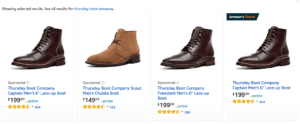
Cameron Priest, CEO, TradeGecko
Entrepreneurs from all over the world sell on Amazon, which recently became the second publicly traded company in the world to cross $1 trillion in market cap, according to CNET.
But with its growing hegemony, including Amazon controlling nearly 50 percent of U.S. e-commerce, entering this space can be daunting, especially as a newcomer. It IS possible to use Amazon to grow and build a profitable business, but if you’re not careful, it’s also possible to get gobbled up whole by Jeff Bezos’ beast.
If you sell on Amazon (or are thinking about it) and want to gain your own firm foothold in the busy marketplace, here are three tactics to safeguard yourself and your business from being trampled by “The Everything Store.”
1. Use Data to Validate Product Development
Amazon uses data to truly understand customer buying behaviors and drive which products to develop. Ironically, much of this data comes from the very businesses that may soon find themselves competing with the behemoth.
Last year, for the first time in its history, more than half of the units sold on Amazon worldwide were from third-party accounts, including 300,000 U.S. based small and medium-sized businesses (SMBs). The more sellers on Amazon; the more data they have.
But it’s possible to use this to your advantage.
Consumer electronics company, Anker—founded by ex-Google employee, Stephen Yang—became intimately familiar with Amazon’s marketplace. After discovering what worked and what didn’t as a seller, The Verge reported that Anker leveraged Amazon’s wealth of resources to springboard into its own online storefront, brick-and-mortar retailers and other marketplaces, and to diversify its product lines.

Anker has become a major seller of consumer electronics on Amazon.com.
In addition, what few SMBs know about—and even less take advantage of—are data repositories that let you see exactly which products are selling, at what rate and their price points. Multiple providers—like camelcamelcamel, Unicorn Smasher, Jungle Scout, AMZScout, JeeQ Data and more—offer free, as well as paid, options to help inform your on and off of Amazon strategies.
2. Design Your Merchandising Strategy Deliberately
Amazon’s Marketplace can be an enormous source of revenue, but it can also become your biggest competitor. If there’s a lesson to be learned here, we can learn it from German knife-maker Wüsthof.
Four years ago, Amazon stopped adhering to Wüsthof’s Minimum Advertised Price (MAP) policy. The retail giant began heavily discounting Wüsthof products in an effort to provide the lowest prices in the market to consumers. The German knife-maker cut ties with Amazon, and still to this day, doesn’t use Amazon to sell its products.
However, this didn’t stop Amazon from sourcing Wüsthof knives through third-party sellers. What this means is that we should treat Amazon symbiotically.
Amazon has people whose job is to actively source the products that they know customers want. Thursday Boot Company, for example, deliberately designs its product strategy with this in mind.
On Amazon, the company offers a very small selection of its products to choose from compared to its own online store, which features a wider variety. Thursday chooses the staples—its best-sellers—that will provide the most exposure and cut-through on Amazon’s marketplace, and then keep new releases and a wider selection available on its site.

Thursday Boot Company offers a limited selection on Amazon and more choices on its own site.
This deliberate product strategy allows Thursday Boot Company to showcase its product to a wide audience on Amazon while maintaining its integrity as a premium handcrafted product.
You can do the same with your business: Use Amazon to attract more attention to your best products as an appetizer, then lead them to your site for the main course and the rest of your products.
3. Hone an Unforgettable Post-Purchase Experience
Amazon works with manufacturers to box products in “Certified Frustration-Free Packaging”—also known as a plain brown box. Its packaging has been designed to open easily, reduce waste and protect its contents from the elements.
This functional focus means that, while you may not be able to compete with Amazon on shipping, you can still beat them on the fulfillment experience.
If you outsource, services like Lumi and Quiet Logistics can help you build a customized fulfillment solution. Numerous medium-sized companies, as well as high-value brands like Bonobos, are already proving their worth.
On the other hand, if you take care of fulfillment in-house, put some love into your packaging and focus on delighting the customer. For that, we can look to John’s Crazy Socks for inspiration.
John’s Crazy Socks is a retailer with an incredibly heartwarming story that permeates everything it does. This father-and-son operation knows it is competing against retail giants like Amazon, so the retailer focuses on making the shipping and handling of its products a truly unique experience for customers.

John’s Crazy Socks is a father-son venture inspired by co-founder John Lee Cronin, a young man with Down syndrome who loves flamboyant hosiery.
John’s Crazy Socks is a father-son venture inspired by co-founder John Lee Cronin, a young man with Down syndrome who loves flamboyant hosiery.
Each colorful box is carefully hand-packed with little surprises like candy, discount coupons and a personalized card from John. When you combine a beautiful narrative, a huge selection of products and a delightful post-purchase experience, you get customers who rave about the company and are willing to pay more for John’s Crazy Socks.
So, what can you do to make customer experience more delightful? Start by thinking about how you’d want to receive a package. What would make you smile? Or more important, what would be unexpected and go above and beyond what you thought you’d already paid for?
All in all, Amazon is here to stay, and it’s crucial that you know how to make it work to your advantage. Use the data available to you to validate product development and when it comes to product strategy, don’t be afraid to keep some cards close to your chest. Think about the types of post-purchasing experiences you’ve had before and loved, then adapt that thinking to what you are offering your customers.
TradeGecko provides inventory management software for online retailers.
